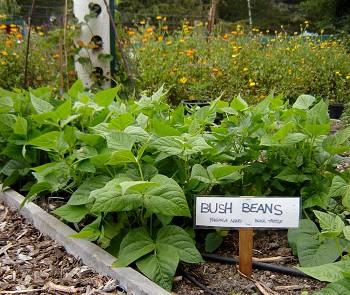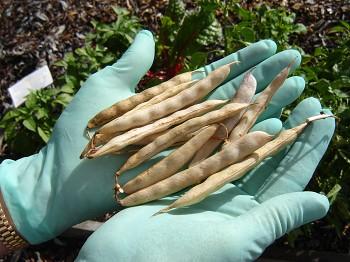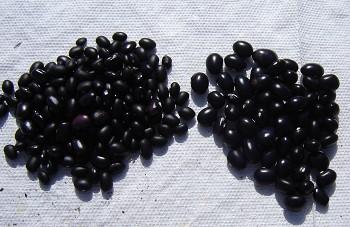Black bush bean trials
In 2009, Master Gardener Lisa Abramson and other Master Gardener volunteers conducted a trial of two types of dried black beans.
They wanted to find out whether two varieties of bush bean – Fagiolo nano and Black Turtle Bush – would grow well in our zone 17 coastal climate, and reach maturity in time to harvest as dry beans before the rains came. Even with a late start date of June 2, we made it!
Beans can be harvested at three different stages of development. Snap beans (also called string or green beans) are harvested when the pods are still young and tender and the seeds are undeveloped. In this case, you eat the whole pod - shell and all. Shell beans are harvested a little later when the pods have swollen and the seeds are still tender. Beans are shucked from the pod and cooked or eaten fresh. Dried beans are harvested when the plant has fully matured, leaves have turned completely brown, and the seeds are hard and dry. These beans can be kept for up to 12 months if dried and stored properly. Both of our black bean types are grown as dried beans.
Planting
Beans are a warm season crop, and grow best when temperatures average between the 70’s and 80’s, and when the soil has warmed up to at least 65°F. As they are frost tender and susceptible to rot, you don’t want to plant when the soil is still soggy and cold. Although we knew June might be a little late to start, we decided to go ahead and run the trial. We planted on June 2.
Seeds of both these varieties should be planted 1” deep every 2-4” in rows 12-14” apart, then thinned to 6” apart. Ideally, plants will be close enough together to shade out the weeds, but far enough apart to allow for good air circulation. This helps prevent disease and is especially important for dried beans as they stay on the plant for so long.
Beans prefer a fertile, well-drained soil with a slightly acid pH (about 6.5). We planted on June 2 in native soil mixed with rich barn manure, in full sun, with drip irrigation. Germination usually takes from 5-8 days, and after the first week we had good germination of the Black Turtle beans, but only about half of the Fagiolo nano beans had come up. On June 16 we planted more Fagiolo beans and these germinated successfully.
Fertilizer
As part of the legume family, beans are able to convert nitrogen from the air into a form that is usable by the plant. They do this in partnership with Rhizobia bacteria, which form nodules on the roots of the plant. Because of this, they don’t need to be fertilized heavily with nitrogen once the roots have been established (usually after the first 6 weeks). Too much nitrogen will increase foliage but reduce the number of beans. Because the existing soil was already very fertile, we did not apply any more fertilizer during the season. If your soil requires it, you can use a mild fish emulsion every 2 weeks for the first 6 weeks, then once every 2-3 weeks after that.
Because we hadn’t planted beans in this bed before (if we had, the Rhizobia bacteria would have already been in there), we inoculated the seeds with a black powder containing the bacteria before planting (inoculant can be purchased in small amounts from retail nurseries or seed companies). To inoculate, place the seeds in a baggie with the powder and shake until thoroughly coated. This step is not required, but we used it as extra insurance.
Summer care

In August we had an aphid infestation on both varieties, but were able to control it using water spray, being careful not to disturb the blooms and pods. (Simply knock the aphids off the plant using water from a spray nozzle and hose. This may need to be repeated a few days in a row to remove all the aphids. It can be done at any time during the season that you discover aphids on your plants). Here we realized that we should have spaced our plants further apart to make it harder for pests to spread. Our rows were about 8” apart; 12-14” would have been better.

The Black Turtle Beans matured a little earlier than the Fagiolo nano. We were careful to leave the pods of both varieties on the plant until they were completely dry and the beans were jet black and hard.
Our first harvest was in late September when we took about a third of the Black Turtle Beans. Then, on October 12 the majority of both Fagiolo nano and Black Turtle were ready to be picked. A few remained to dry further and were finally harvested on October 20 and 27, and the plants were pulled out and composted. We wanted to harvest before any rain, which can interfere with the drying process and cause mold to grow on the pods. (If you do get caught, plants can be cut down to the ground once the pods have turned yellow and hung upside down to dry indoors).
We chose the old-fashioned method of picking pods off the plant individually and shelling them by hand, then laying the beans on a cookie sheet to dry further for a couple of days (ideally, moisture content will be about 12% when fully dried). Another suggested method is to take a handful of plants and put them in a pillowcase, knocking them against a hard surface until the beans come out of the pods. The important thing is to make sure they are completely dry before storing them in a clean, airtight container. They can be kept this way for up to 12 months, after that the flavor and nutritional value declines, and the cooking time increases.

We were pleased to find not one, but two varieties of bush beans that will produce dried beans, even in cooler coastal areas of San Mateo County.
